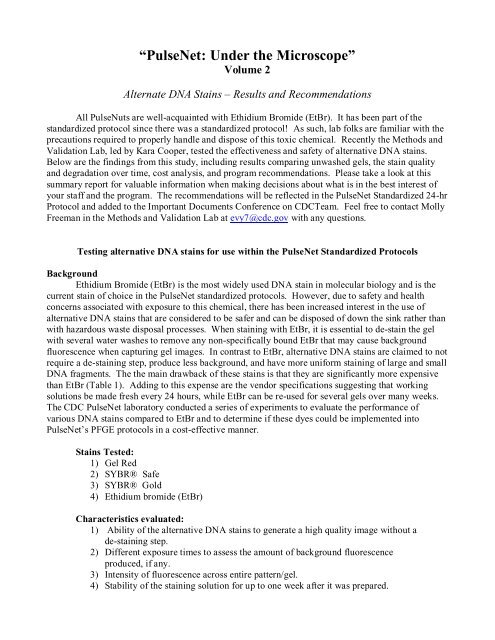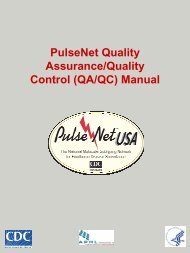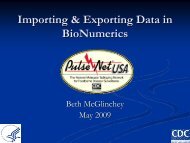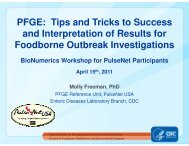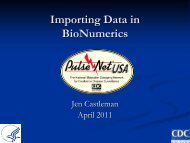ethidium bromide, SYBR Safe, SYBR Gold, GelRed - PulseNet ...
ethidium bromide, SYBR Safe, SYBR Gold, GelRed - PulseNet ...
ethidium bromide, SYBR Safe, SYBR Gold, GelRed - PulseNet ...
You also want an ePaper? Increase the reach of your titles
YUMPU automatically turns print PDFs into web optimized ePapers that Google loves.
“<strong>PulseNet</strong>: Under the Microscope”<br />
Volume 2<br />
Alternate DNA Stains – Results and Recommendations<br />
All PulseNuts are well-acquainted with Ethidium Bromide (EtBr). It has been part of the<br />
standardized protocol since there was a standardized protocol! As such, lab folks are familiar with the<br />
precautions required to properly handle and dispose of this toxic chemical. Recently the Methods and<br />
Validation Lab, led by Kara Cooper, tested the effectiveness and safety of alternative DNA stains.<br />
Below are the findings from this study, including results comparing unwashed gels, the stain quality<br />
and degradation over time, cost analysis, and program recommendations. Please take a look at this<br />
summary report for valuable information when making decisions about what is in the best interest of<br />
your staff and the program. The recommendations will be reflected in the <strong>PulseNet</strong> Standardized 24-hr<br />
Protocol and added to the Important Documents Conference on CDCTeam. Feel free to contact Molly<br />
Freeman in the Methods and Validation Lab at evy7@cdc.gov with any questions.<br />
Testing alternative DNA stains for use within the <strong>PulseNet</strong> Standardized Protocols<br />
Background<br />
Ethidium Bromide (EtBr) is the most widely used DNA stain in molecular biology and is the<br />
current stain of choice in the <strong>PulseNet</strong> standardized protocols. However, due to safety and health<br />
concerns associated with exposure to this chemical, there has been increased interest in the use of<br />
alternative DNA stains that are considered to be safer and can be disposed of down the sink rather than<br />
with hazardous waste disposal processes. When staining with EtBr, it is essential to de-stain the gel<br />
with several water washes to remove any non-specifically bound EtBr that may cause background<br />
fluorescence when capturing gel images. In contrast to EtBr, alternative DNA stains are claimed to not<br />
require a de-staining step, produce less background, and have more uniform staining of large and small<br />
DNA fragments. The the main drawback of these stains is that they are significantly more expensive<br />
than EtBr (Table 1). Adding to this expense are the vendor specifications suggesting that working<br />
solutions be made fresh every 24 hours, while EtBr can be re-used for several gels over many weeks.<br />
The CDC <strong>PulseNet</strong> laboratory conducted a series of experiments to evaluate the performance of<br />
various DNA stains compared to EtBr and to determine if these dyes could be implemented into<br />
<strong>PulseNet</strong>’s PFGE protocols in a cost-effective manner.<br />
Stains Tested:<br />
1) Gel Red<br />
2) <strong>SYBR</strong>® <strong>Safe</strong><br />
3) <strong>SYBR</strong>® <strong>Gold</strong><br />
4) Ethidium <strong>bromide</strong> (EtBr)<br />
Characteristics evaluated:<br />
1) Ability of the alternative DNA stains to generate a high quality image without a<br />
de-staining step.<br />
2) Different exposure times to assess the amount of background fluorescence<br />
produced, if any.<br />
3) Intensity of fluorescence across entire pattern/gel.<br />
4) Stability of the staining solution for up to one week after it was prepared.
Table 1. Estimated cost per working solution of the stains tested.<br />
Stain Type<br />
Stain<br />
Cost<br />
Disposal<br />
Cost<br />
Total<br />
Cost<br />
<strong>SYBR</strong>® <strong>Safe</strong><br />
(Invitrogen) $5.88 $0.00 $5.88<br />
<strong>SYBR</strong>® <strong>Gold</strong><br />
(Invitrogen) $11.70 $0.00 $11.70<br />
<strong>GelRed</strong><br />
(Biotium) $9.50 $0.00 $9.50<br />
EtBr<br />
(Sigma) $0.23 $2.89 $3.12<br />
Experiment 1<br />
Set-up<br />
A 15-well gel containing H9812 was run and subsequently cut into four parts and stained for<br />
30 minutes with EtBr, <strong>GelRed</strong>, <strong>SYBR</strong>® <strong>Safe</strong>, or <strong>SYBR</strong>® <strong>Gold</strong>. The portion stained with EtBr was<br />
de-stained before imaging while the others were imaged immediately (without destaining). Each gel<br />
portion was imaged with increasing exposure times to evaluate the image quality over a broad time<br />
range. The initial exposure time varied depending on the stain being used, however the range of time<br />
between the first and last image captured was the same. The stains were prepared following vendor<br />
recommendations and stored in light-protected containers.
Figure 1. Comparison of images obtained after staining with EtBr or <strong>SYBR</strong>® <strong>Gold</strong> using increasing<br />
exposure times.<br />
EtBr<br />
<strong>SYBR</strong>® <strong>Gold</strong><br />
Increasing exposure time<br />
Results<br />
As the exposure time increased, additional background (gray) was observed on gels stained<br />
with EtBr. High background is a common problem during image acquisition and can complicate<br />
image analysis by reducing the contrast between the bands and the blank gel background.<br />
Additionally, the fluorescence within the bands increases significantly and they appear thicker and<br />
less sharp. Avoiding over-integration is particularly important when analyzing very complex<br />
patterns in which multiple bands migrate close together. In this situation, high background and<br />
thick bands may mask clues (white space between bands or shoulders) that indicate the presence of<br />
two bands. However, with the alternative DNA stains, as the exposure time increased, very little<br />
background was observed, the amount of fluorescence within the bands varied little and the bands<br />
remained distinct. This suggested that these stains can produce a relatively similar image over a<br />
broad range of exposure times. Due to this, laboratories may be less likely to over-expose their<br />
images.
Experiment 2<br />
Set-up<br />
A 15-well gel containing H9812 was run and subsequently cut into four parts and stained for<br />
30 minutes with EtBr, <strong>GelRed</strong>, <strong>SYBR</strong>® <strong>Safe</strong>, or <strong>SYBR</strong>® <strong>Gold</strong>. The gel portion stained with<br />
EtBr was de-stained before imaging while the others were imaged immediately. The stains were<br />
prepared following vendor recommendations and stored in light protected containers. The stability<br />
of the stains was evaluated by staining similar H9812 gel sections on Day 1, 2, and 7.<br />
Figure 2. Comparison of dye stability over time.<br />
EtBr<br />
<strong>SYBR</strong>® <strong>Gold</strong><br />
Day 1 Day2 Day 7 Day 1 Day2 Day 7<br />
<strong>SYBR</strong>® <strong>Safe</strong><br />
<strong>GelRed</strong><br />
Day1 Day 2 Day 7 Day1 Day 2 Day 7
Results<br />
In general, very little difference in fluorescence intensity was observed between the gel stained on day<br />
one and those on subsequent days with each of the stains tested. However, with both <strong>SYBR</strong>® dyes a<br />
slight graying of the bands was seen by Day 7. This may be due to light exposure and stain<br />
degradation as containers were wrapped in aluminum foil and left out on the bench top. Consequently<br />
for later tests, these containers were stored in a cabinet and the gray appearance of the gels on Day 7<br />
with the <strong>SYBR</strong>® dyes was not observed.<br />
Experiment 3<br />
Set-up<br />
A 15-well gel containing two Salmonella isolates flanked on both sides with H9812 repeated 3<br />
times was run. The gel was cut into three parts and stained for 30 minutes with <strong>GelRed</strong> at 1, 2, and<br />
3× concentration. The stability of the <strong>GelRed</strong> at the various concentrations was evaluated by<br />
staining similar gel sections on Day 1, 3, and 7.<br />
Day 1<br />
<strong>GelRed</strong><br />
1X<br />
2X<br />
3X
Day 3<br />
<strong>GelRed</strong><br />
1X<br />
2X<br />
3X<br />
Day 7<br />
<strong>GelRed</strong><br />
1X 2X 3X<br />
Results<br />
No variation in fluorescence intensity was observed between the different concentrations of<br />
<strong>GelRed</strong> stain. Additionally, the stains at each concentration were shown to be stable over 7 days.
Experiment 4<br />
Set-up<br />
Additional isolates were tested with the alternative DNA stains (<strong>GelRed</strong>, <strong>SYBR</strong>® <strong>Safe</strong>, or<br />
<strong>SYBR</strong>® <strong>Gold</strong>) and the patterns were compared to those generated with EtBr.<br />
Figure 4. Comparison of banding patterns generated with either EtBr or <strong>SYBR</strong>® <strong>Safe</strong>.<br />
EtBr<br />
<strong>SYBR</strong>® <strong>Safe</strong><br />
Results<br />
No noticeable difference was observed in the appearance of the banding patterns when stained<br />
with either EtBr or any of the alternative DNA stains.<br />
Summary and Conclusions<br />
The alternative DNA stains successfully stained PFGE gels and generated patterns comparable<br />
to those generated with EtBr. One advantage of these stains is that de-staining is not necessary – gels<br />
can be directly imaged, saving time. Another advantage is that the resulting images have a limited<br />
amount of flourecscene over a wide range of exposure times. This is in contrast to EtBr which requires<br />
careful identification of the appropriate exposure time to avoid over-integration and background<br />
fluorescence which complicates image analysis. These advantages come with a relatively increased<br />
cost compared to EtBr. This cost increase would be even higher if laboratories need to make the<br />
working solutions fresh each day as recommended by the vendor. Because of this, we evaluated the<br />
appearance of gels stained with these alternative DNA stains during the course of a week. In general,<br />
they were found to generate similar looking images suggesting that these stains are stable for repeated<br />
use over the course of at least one week. We recommend storing these stain solutions in a lightprotected<br />
box within a cabinet to decrease exposure to light and subsequent deterioration.<br />
The <strong>PulseNet</strong> Method Development and Reference Laboratory would like to announce that<br />
laboratories wishing to begin implementing using these stains within their own laboratories to stain<br />
<strong>PulseNet</strong> PFGE gels are welcome to do so. The current <strong>PulseNet</strong> Standardized protocols will be edited<br />
to include these stains as options for use by <strong>PulseNet</strong> certified laboratories.


